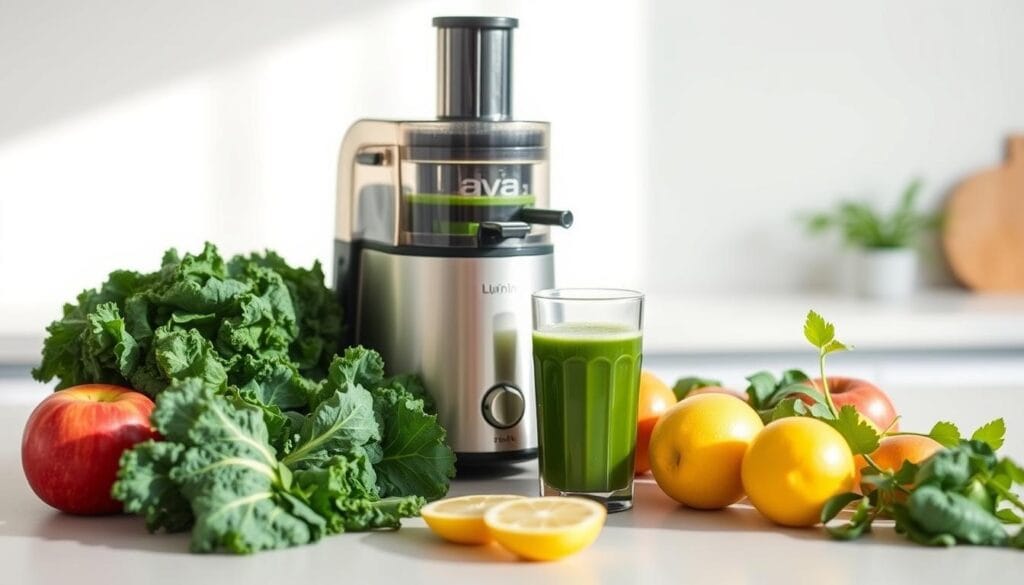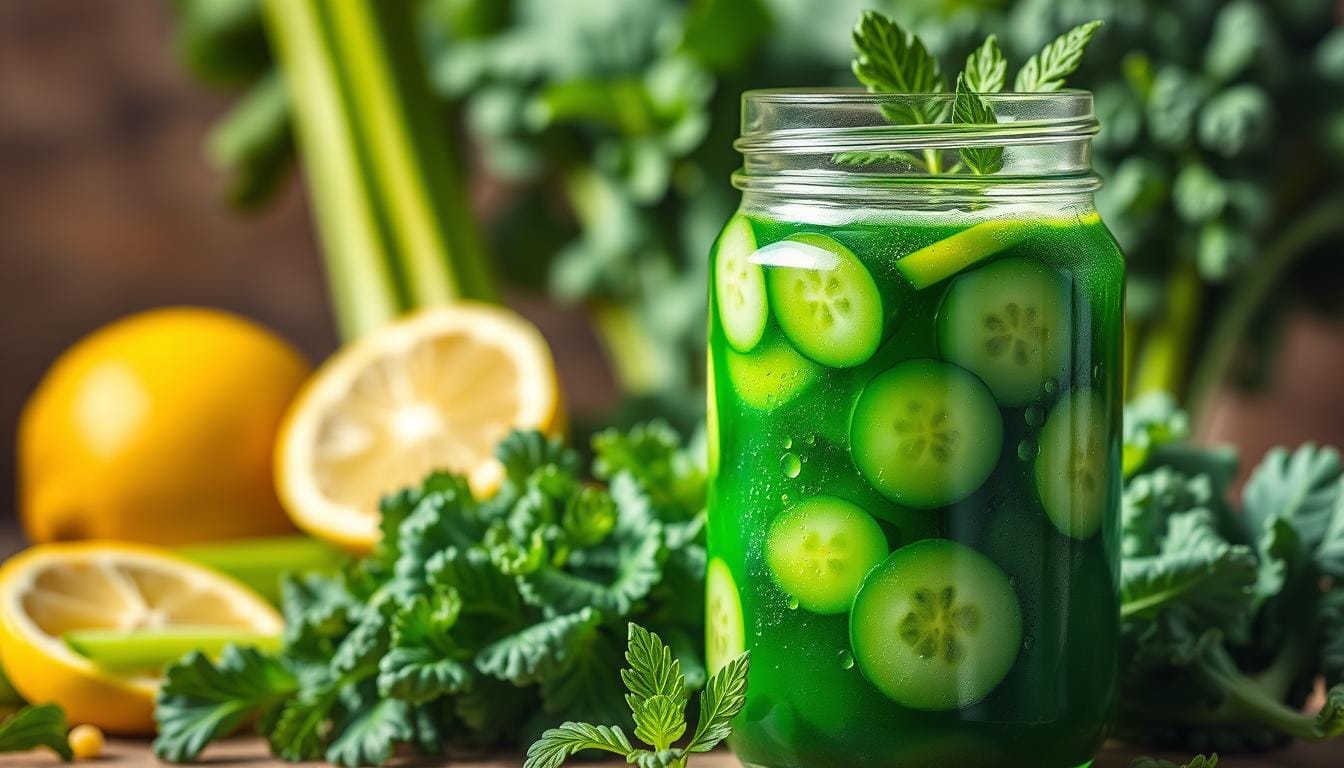Green Juice Recipe: How to Make a 7-Day Detox for Weight Loss
Ever feel like your body needs a reset? You’re not alone. Many of us struggle with sluggish energy, cravings, or bloating—especially after indulging. That’s where a simple, nutrient-packed drink can make all the difference.
I started blending this 6-ingredient mix two months ago, and the results surprised me. Within days, my energy soared, and those mid-afternoon snack attacks vanished. Best of all? It takes just 15 minutes to prepare.
This isn’t just another fad. It’s a Mediterranean-diet-friendly way to support digestion, boost metabolism, and kickstart weight loss. Plus, skipping store-bought versions saves money—and lets you control every fresh ingredient.
Ready to feel lighter and more vibrant? Let’s dive into your 7-day detox plan. Your mornings (and waistline) will thank you.
Table of Contents
Benefits of Green Juice for Detox and Weight Loss
What if one simple change could skyrocket your energy and digestion? This drink isn’t just a trend—it’s a science-backed way to revitalize your body. Packed with vitamins and minerals, it tackles fatigue, gut issues, and toxins head-on.
Boosts Energy and Metabolism
Leafy greens like kale and spinach deliver iron and magnesium, which combat fatigue. Ginger’s natural compounds fire up your metabolism, helping you burn calories efficiently.
One study noted:
“Participants reported sustained energy levels and reduced caffeine dependence.”
Supports Digestive Health
Ginger’s anti-inflammatory properties soothe your gut, while celery’s fiber promotes regularity. Together, they improve digestive health and reduce bloating.
- Balances gut bacteria
- Eases indigestion
- Curbs sugar cravings
Enhances Detoxification
Celery supports liver function, your body’s natural detox hub. Antioxidants from greens flush toxins, while fiber binds to waste for elimination.
Pro tip: Keep the pulp to maximize fiber’s detoxification benefits. Your immune system gets a boost too!
Ingredients for the Perfect Green Juice Recipe
The secret to a powerful blend lies in its fresh, nutrient-rich components. Each ingredient plays a unique role—boosting energy, aiding digestion, or adding natural sweetness. Here’s what makes these greens and extras stand out.

Kale: The Superfood Base
Packed with vitamins K and C, kale supports bone health and iron absorption. Its high fiber content keeps you full longer, while folate aids cellular repair. For best results, use curly or Lacinato varieties.
Ginger: A Digestive Aid
A 1-inch piece of ginger soothes nausea and fights inflammation. Its active compound, gingerol, strengthens the immune system. Grate it finely to maximize flavor and benefits.
Apple and Cucumber: Natural Sweetness and Hydration
Opt for Granny Smith apple—it’s tart and lower in sugar than sweeter varieties. Cucumber adds hydration, and its thin skin blends easily. Together, they balance earthy flavors without overpowering.
How to Make Green Juice: Step-by-Step Guide
Mastering this vibrant blend is easier than you think. With the right tools and a few minutes, you’ll unlock a refreshing, nutrient-rich drink. Here’s how to do it—from prep to pour.

Prepping Your Ingredients
Wash all produce thoroughly to remove dirt or pesticides. Chop kale, celery, and apples into small chunks for easier blending or juicing. Store prepped ingredients in an airtight container overnight to save time.
“Pre-chopping cuts morning prep to under 5 minutes,” notes a nutritionist.
Juicing or Blending Techniques
For a juicer, feed ingredients slowly to maximize yield. If using a blender (like Vitamix or Ninja), blend on high for 60 seconds. Add water gradually to thin the mix.
Pro tip: Use the tamper to push down stubborn greens. Strain through a nut milk bag or fine mesh sieve for a smoother texture.
Serving Suggestions
Drink immediately for peak freshness or refrigerate for up to 24 hours. Shake well before serving—natural separation is normal. Leftover pulp? Bake it into crackers or add to soups for extra fiber.
- Blender fans: Freeze portions in ice cube trays for smoothies.
- Juicer users: Compost pulp or mix into dog treats.
Blender vs. Juicer: Which One Should You Use?
Choosing the right tool can make or break your juicing experience. Both appliances extract nutrients but differ in texture, fiber content, and prep time. Your goals—convenience, nutrition, or versatility—determine the best fit.
Pros and Cons of Using a Blender
Blenders are kitchen staples. They chop whole ingredients, retaining pulp unless strained. Perfect for thick smoothies or fiber-packed drinks.
- Pros: No specialized gear needed. Keeps fiber for digestion.
- Cons: Longer cleanup. Separation occurs if stored.
Pros and Cons of Using a Juicer
Juicers extract liquid efficiently, leaving dry pulp behind. Ideal for silky-smooth textures but sacrifice some nutrients.
- Pros: Quick process. No chunks.
- Cons: Pricier. Discards fiber-rich pulp.
Tip: Use a blender if you’re budget-conscious. Opt for a juicer if you crave speed and refinement daily.
Green Juice Variations for a 7-Day Detox
Keep your detox exciting with fresh twists on classic blends. Rotating ingredients prevents nutrient overload and keeps your taste buds engaged. Each variation targets specific benefits—from immune system support to anti-inflammatory effects.
Spinach and Citrus Twist
Swap kale for spinach on Day 1 for a milder, iron-rich base. Add orange segments for a vitamin C boost that enhances iron absorption. The citrus flavor balances earthy greens perfectly.
- Use lime or grapefruit for a tangier kick.
- Add a pinch of cayenne to amplify metabolism.
Turmeric and Ginger Boost
Day 3 calls for golden turmeric—its curcumin fights inflammation. Pair it with ginger and black pepper to activate absorption. This combo supports joint health and immune system function.
“Turmeric’s antioxidants may reduce oxidative stress by 30%,” suggests a 2022 study.
Herb-Infused Options
Fresh herbs like basil or mint elevate Day 5’s flavor. They aid digestion and add a refreshing aroma. For sweetness, try carrot and tomato on Day 7—lycopene-rich and hydrating.
- Basil: Soothes bloating.
- Mint: Cools digestion naturally.
How to Store and Enjoy Your Green Juice
Preserving freshness is key to enjoying your blend longer. Proper storage locks in nutrients and flavor, while creative reuse minimizes waste. Here’s how to make every drop—and bit of pulp—count.
Best Practices for Freshness
Use glass containers instead of plastic to avoid chemical leaching. An airtight jar keeps oxygen out, slowing oxidation. Label batches with dates and discard after 72 hours.
For longer storage, freeze portions in ice cube trays. Thaw overnight and shake well—natural separation is normal. Pro tip: A nut milk bag strains pulp efficiently for smoother texture.
Creative Ways to Use Leftover Pulp
Don’t toss the pulp—it’s packed with fiber. Mix it into soups, muffin recipes, or compost it. For a nutrient boost, dehydrate and blend it into greens powder.
- Bake it: Add to crackers or veggie burgers.
- Blend it: Stir into smoothies for thickness.
- Season it: Sprinkle dried pulp as a savory topping.
“Pulp reuse reduces food waste by 40% in home kitchens,” notes a sustainability report.
Conclusion
This 7-day plan offers a simple way to recharge your body with essential nutrients. While not a substitute for whole veggies, it’s a powerful supplement for detox, energy, and digestion support.
Feel free to tweak ingredient ratios to match your taste. If you have health concerns, consult a doctor before starting. For more ideas, explore our Mediterranean diet recipes and premium olive oil selection.
Ready to take the next step? Join our newsletter for weekly tips or share your results with #FreshStart. Your journey to a lighter, more vibrant you starts now!
FAQ
Can I use frozen fruits and veggies?
Fresh ingredients work best for maximum nutrients, but frozen options can be used if needed. Just thaw them slightly before blending.
How long does homemade juice stay fresh?
Store it in an airtight container in the fridge for up to 48 hours. For longer freshness, freeze it in ice cube trays.
Do I need to peel apples and cucumbers?
Organic produce can be juiced with the skin for extra fiber. If non-organic, peeling reduces pesticide exposure.
Can I replace kale with other leafy greens?
Yes! Spinach, Swiss chard, or romaine lettuce make great alternatives while keeping the nutrient density high.
Will this help with bloating?
Ingredients like ginger and cucumber support digestion and may reduce water retention when consumed regularly.
Is a blender or juicer better for this?
A juicer removes pulp for a smoother texture, while a blender retains fiber. Choose based on your preference.
Can I add protein powder?
Absolutely! Stir in unflavored plant-based protein after blending to avoid clumping and boost satiety.

